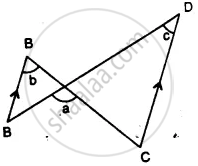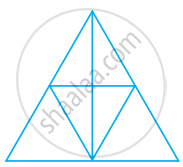Advertisements
Advertisements
Question
In the given figure, show that: ∠a = ∠b + ∠c

(i) If ∠b = 60° and ∠c = 50° ; find ∠a.
(ii) If ∠a = 100° and ∠b = 55° : find ∠c.
(iii) If ∠a = 108° and ∠c = 48° ; find ∠b.
Solution
∵ AB || CD
∴ b = c and ∠A = ∠C ........(Alternate angles)
Now in Δ PCD,
Ext. ∠APC = ∠C + ∠D
⇒ a = b + c
(i) If b = 60°, c = 50°, then
a = b + c = 60° + 50° = 110°
(ii) If a = 100° and b = 55°,
then a = b + c
⇒ 100° = 55°+ c
⇒ c = 100°− 55° = 45°
(iii) If a = 108° and c = 48°
then a = b + c
⇒ 108° = b + 48°
⇒ b = 108°− 48° = 60°
APPEARS IN
RELATED QUESTIONS
If the angles of a triangle are in the ratio 1: 2 : 3, determine three angles.
If each angle of a triangle is less than the sum of the other two, show that the triangle is acute angled.
If the bisector of the exterior vertical angle of a triangle be parallel to the base. Show that the triangle is isosce
Is the following statement true and false :
If one angle of a triangle is obtuse, then it cannot be a right angled triangle.
Mark the correct alternative in each of the following:
If all the three angles of a triangle are equal, then each one of them is equal to
The angle of a vertex of an isosceles triangle is 100°. Find its base angles.
One of the base angles of an isosceles triangle is 52°. Find its angle of the vertex.
If an angle of a triangle is equal to the sum of the other two angles, find the type of the triangle
D is any point on side AC of a ∆ABC with AB = AC. Show that CD < BD.
The number of triangles in figure is ______.
